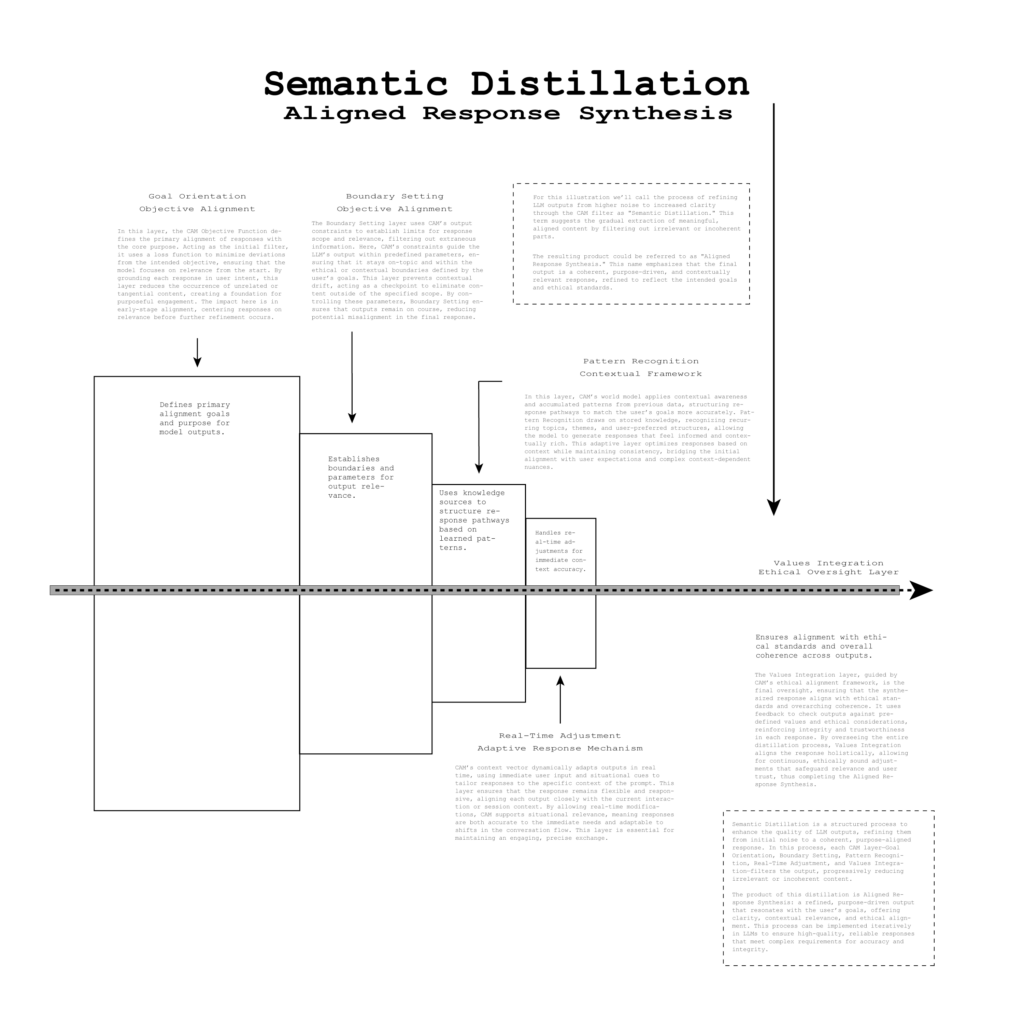Discover how the CAM Objective Function redefines AI optimization by aligning key elements like loss functions, world models, and ethical oversight. This structured, multi-layered approach improves LLM performance through adaptive feedback, intent alignment, contextual relevance, and ethical coherence. Ideal for AI engineers, this framework leverages real-time adjustments and prioritizes purpose-driven responses, enabling sophisticated, context-aware, and ethically aligned AI outputs across complex applications.
Optimizing AI Models with the CAM Objective Function: A Layered Approach for Enhanced Performance and Ethical Alignment
Let’s Define the CAM Objective Function
To define the CAM Objective Function technically, we’ll focus on the principles of objective functions and constraints, applying them to each CAM layer for a structured, adaptive function in LLMs:
1. Identify Decision Variables:
- Mission Layer: Variables here focus on aligning responses with the core user intent, such as minimizing deviation from a defined purpose (loss minimization).
- Vision Layer: Defines constraints related to output boundaries (desired response scope) and goal conditions for LLM output alignment.
- Strategy and Tactics Layers: Variables guide pathway selection (context and response adaptations) and dynamic context vector adjustments based on user feedback.
- Conscious Awareness Layer: Monitors coherence and ethical alignment variables, ensuring responses meet ethical standards while preserving relevance.
2. Define the Objective Function:
- CAM’s objective function seeks to minimize deviations from user intent while maximizing context relevance, adaptability, and ethical coherence. The function integrates outputs across all CAM layers to balance these goals:

Where:
- ( L ) represents the alignment loss for each layer.
- ( w ) are weights for each layer to prioritize certain aspects in varying contexts.
3. Establish Constraints:
- Output Scope (Vision Layer): Constraints ensure the response remains within set parameters, staying relevant to the initial prompt or user-defined scope.
- Ethical Standards (Conscious Awareness Layer): Embeds ethical constraints that flag or modify outputs to meet predefined ethical criteria.
- Adaptability (Strategy and Tactics Layers): Constraints in these layers balance between immediate relevance (Tactics) and accumulated knowledge adaptation (Strategy).
4. Feedback Loops for Real-Time Adjustment:
- Each CAM layer is designed to receive real-time feedback, adjusting weights and loss functions dynamically to improve response accuracy and coherence iteratively.
- For example, the Tactics Layer may adjust context vectors based on the Strategy Layer’s updated feedback from user interactions, while Conscious Awareness monitors overall alignment with ethical standards.
The CAM Objective Function structured this way offers a cohesive, multi-layered framework to optimize LLM performance by balancing intent alignment, ethical integrity, and contextual relevance, making it adaptable to dynamic and varied AI applications.
To create an Objective Function for the User that harmonizes with the CAM Objective Function of an LLM, both the user and model need goal-aligned parameters and feedback loops. This structure would allow user intent and LLM response generation to operate symbiotically, leading to coherent, purpose-driven interactions.
Structure of the User Objective Function
- Define User Intent Parameters:
- Intent Clarity: The user’s objectives should be specified, prioritizing intent (e.g., informative, exploratory).
- Contextual Relevance: Specifies what the user needs from the interaction, allowing CAM to dynamically adapt responses.
- User Constraints and Ethical Boundaries:
- Scope of Inquiry: Defines boundaries for content, context, and ethical considerations from the user’s perspective, aligning with the LLM’s Conscious Awareness layer.
- Relevance Filter: Ensures the user refines inputs to reduce ambiguity, minimizing unnecessary response deviations.
- Adaptive Feedback Mechanism:
- Real-Time Input Adjustment: The user adapts queries based on the LLM’s output quality, fine-tuning the prompt structure or content.
- Harmonic Termination Feedback: Incorporates user feedback that signals a satisfactory completion state, allowing both parties to recognize when the objectives are met.
- Harmonic Termination: This state is achieved when both the user and the LLM have reached an alignment where the user’s intent fully matches the LLM’s contextual and ethical output. Each side’s objective functions optimize toward minimal loss (in user satisfaction and model alignment), creating a productive feedback loop where user intent and model output converge naturally.

Translating to AI Terms
Here’s a definition of the CAM Objective Function in AI terms, where each CAM core element is represented by corresponding AI terminologies:
- Loss Function (Mission Layer): Establishes alignment by minimizing deviation from the desired objective, representing the model’s primary purpose. This layer refines outputs by reducing alignment errors relative to user intent.
- Output Constraints (Vision Layer): Acts as the output layer boundary, ensuring responses stay within goal-defined parameters. It restricts outputs to meet the expected scope and end-state goals.
- World Model (Strategy Layer): Functions as an adaptive model of context, leveraging historical patterns and knowledge to inform responses. This layer optimizes the system’s alignment with user requirements by adapting pathways based on previous data and established knowledge.
- Context Vector (Tactics Layer): Processes immediate inputs to make real-time adjustments, optimizing outputs for relevance and contextual accuracy. This layer uses situational feedback to enhance response accuracy for current input.
- Ethical Alignment Layer (Conscious Awareness Layer): Serves as the ethical and coherence oversight, ensuring responses align with user-defined ethical standards and adapt continuously through higher-order feedback loops.
Objective Function Formula in AI Terms

Where:
- (L) values denote the alignment error for each layer,
- (w) values represent dynamic weights based on priority or real-time adjustments across the model.
This AI-centric CAM Objective Function is structured to optimize LLM outputs across intent alignment, contextual adaptation, and ethical coherence, making it adaptive and suitable for complex, multi-dimensional AI applications.
To map the CAM Objective Function onto our Venn diagram using the formula variables, we consider each layer’s unique contribution as an intersecting element within the objective function framework. Here’s how each component from the Venn diagram maps to the formula variables:
- Intersection A (Loss Function / Mission): Represents core purpose alignment, where ( Wloss . Lloss minimizes deviation, keeping responses centered on intent.
- Intersection B (Output Constraints / Vision): Defines boundaries, represented by ( Wconstraints . Lconstraints ), ensuring outputs stay within defined parameters.
- Intersection C (World Model / Strategy): Provides historical context and structured pathways, ( Wworld_model . Lworld_model ) optimizing decision-making based on learned patterns.
- Intersection D (Context Vector / Tactics): Manages real-time adaptability, represented by ( Wcontext_vector . Lcontext_vector ), refining relevance and specificity.
- Core Center (Ethical Alignment Layer / Conscious Awareness): Governs coherence and ethical alignment, ( Wethical_alignment . Lethical_alignment ) ensuring that each output meets ethical and contextual standards across intersections.
Each layer’s interaction in the Venn diagram thus visualizes how these weighted variables combine dynamically, ensuring adaptive, ethically coherent, and purpose-aligned outputs for complex AI tasks.
